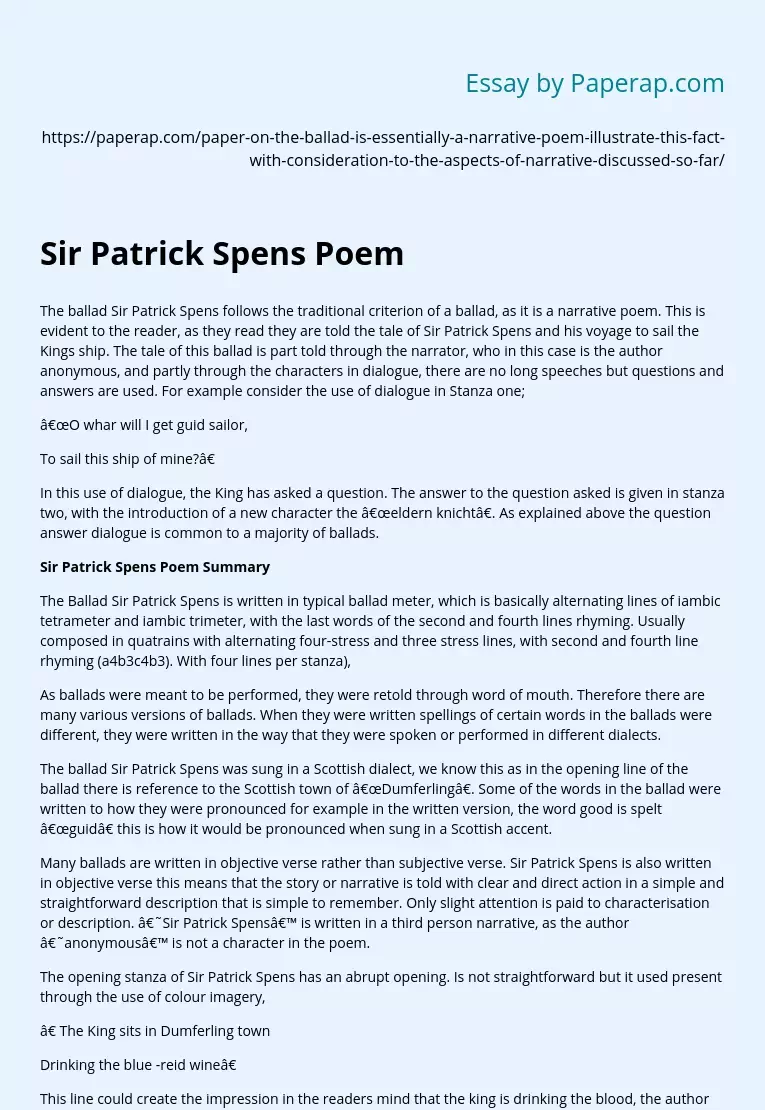Sir Patrick Spens Poem
The ballad Sir Patrick Spens follows the traditional criterion of a ballad, as it is a narrative poem. This is evident to the reader, as they read they are told the tale of Sir Patrick Spens and his voyage to sail the Kings ship. The tale of this ballad is part told through the narrator, who in this case is the author anonymous, and partly through the characters in dialogue, there are no long speeches but questions and answers are used.
For example consider the use of dialogue in Stanza one;
“O whar will I get guid sailor,
To sail this ship of mine?”
In this use of dialogue, the King has asked a question. The answer to the question asked is given in stanza two, with the introduction of a new character the “eldern knicht”. As explained above the question answer dialogue is common to a majority of ballads.
Sir Patrick Spens Poem Summary
The Ballad Sir Patrick Spens is written in typical ballad meter, which is basically alternating lines of iambic tetrameter and iambic trimeter, with the last words of the second and fourth lines rhyming.
Usually composed in quatrains with alternating four-stress and three stress lines, with second and fourth line rhyming (a4b3c4b3). With four lines per stanza),
As ballads were meant to be performed, they were retold through word of mouth. Therefore there are many various versions of ballads. When they were written spellings of certain words in the ballads were different, they were written in the way that they were spoken or performed in different dialects.
The ballad Sir Patrick Spens was sung in a Scottish dialect, we know this as in the opening line of the ballad there is reference to the Scottish town of “Dumferling”. Some of the words in the ballad were written to how they were pronounced for example in the written version, the word good is spelt “guid” this is how it would be pronounced when sung in a Scottish accent.
Many ballads are written in objective verse rather than subjective verse. Sir Patrick Spens is also written in objective verse this means that the story or narrative is told with clear and direct action in a simple and straightforward description that is simple to remember. Only slight attention is paid to characterisation or description. ‘Sir Patrick Spens’ is written in a third person narrative, as the author ‘anonymous’ is not a character in the poem.
The opening stanza of Sir Patrick Spens has an abrupt opening. Is not straightforward but it used present through the use of colour imagery,
” The King sits in Dumferling town
Drinking the blue -reid wine”
This line could create the impression in the readers mind that the king is drinking the blood, the author has carefully used simple ballad colour imagery by using the colour red, to create a shocking effect on the reader. The closing stanza of the ballad is the summarizing stanza where the reader is told that sir Patrick is dead. Death is the ending the final ending in life, the use of death in the last stanza symbolises that it is the end, that there is nothing else after it. This is however also an abrupt ending as we are not really told of the emotions or feeling of the women who have just lost their partners, nor of Sir Patrick Spens or his crew as they died.
Sir Patrick Spens Poem. (2019, Dec 05). Retrieved from https://paperap.com/paper-on-the-ballad-is-essentially-a-narrative-poem-illustrate-this-fact-with-consideration-to-the-aspects-of-narrative-discussed-so-far/

